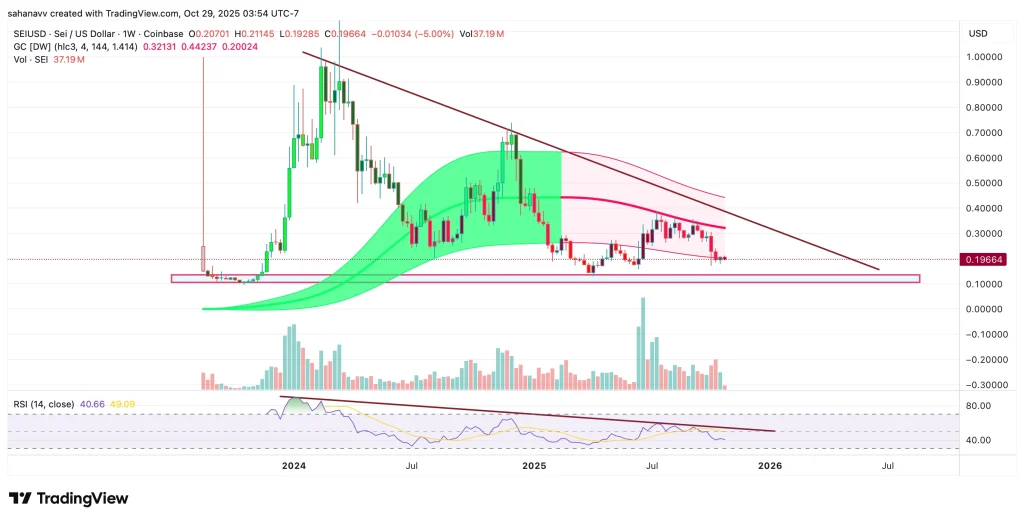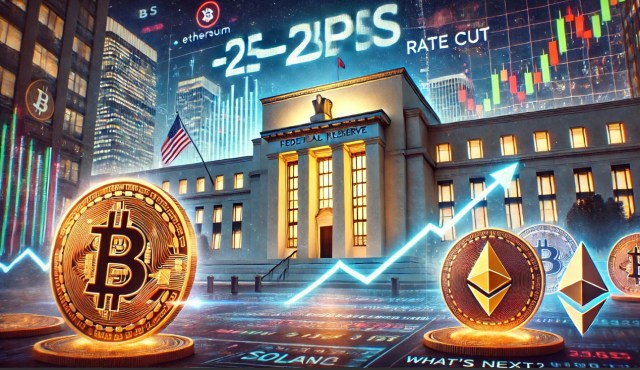SEI Price: Institutional Surge Could Trigger the Next Big Rally
TLDR:
-
SEI trades near yearly lows, testing key support levels.
-
Institutional activity is growing rapidly on the Sei Network.
-
Over $10B in DEX volume and ETF exposure boost long-term outlook.
-
Technicals hint at possible rebound if $0.17 holds.
-
Ecosystem expansion could trigger a sharp recovery.
SEI has entered a decisive phase after weeks of downward pressure, now hovering near its yearly lows. Despite weak sentiment, the Sei Network continues to strengthen its ecosystem foundations, positioning itself as one of the most advanced trading-focused Layer-1 blockchains in the market.
 SEI Price
SEI Price
Network fundamentals remain solid. Sei’s architecture delivers ultra-fast execution and deep liquidity aggregation, supporting its vision of becoming the go-to infrastructure for decentralized trading and real-world asset tokenization.
Why SEI Price Struggles Despite Strong Fundamentals
SEI’s current weakness stems from a combination of macro and internal factors. Declining liquidity has magnified even minor sell-offs, while delayed ecosystem growth has reduced market enthusiasm.
Token unlocks continue adding sell pressure, and investor attention has shifted toward larger-cap coins like $BTC and $ETH.
Layer-1 fatigue is also playing a role. With dozens of competing chains, SEI must now prove tangible utility to regain momentum.
Yet, despite low price action, Sei’s throughput, reliability, and institutional traction remain unmatched among newer blockchains.
A critical near-term support sits at $0.17, with resistance forming near $0.24. A rebound above that zone could open the door to $0.30—marking the start of renewed accumulation.
However, a break below $0.17 may signal continued consolidation toward $0.12.
Institutions Are Quietly Building on Sei
While retail sentiment cools, institutions are moving in. More than $10B in DEX volume has already passed through Sei, and multiple ETFs with SEI exposure have emerged in the U.S. Major players—BlackRock, Apollo, Hamilton Lane, Ondo, and Securitize—are actively testing or deploying tokenized funds on the network.
This influx of institutional-grade projects highlights Sei’s unique edge. Unlike general-purpose Layer-1s, Sei is optimized for trading performance and real-world finance integrations.
As regulatory clarity improves, this alignment could make Sei a primary hub for tokenized assets and RWAs.
SEI Price Outlook for November
If the institutional narrative continues gaining traction, SEI could rebound toward $0.21–$0.24 in the short term, with a potential breakout to $0.30.
Technical indicators show weakening bearish momentum, and the RSI near 40 signals possible reversal conditions.
 Source: TradingView
Source: TradingView
However, failure to defend $0.17 support could extend the current downtrend. Long-term investors may view this zone as a high-risk, high-reward accumulation range—especially if Sei maintains its growth in liquidity and cross-chain integrations.
With institutions already active and major asset tokenizations occurring, Sei’s next rally could coincide with renewed confidence in real-world blockchain finance.
The foundation is set; now it’s about sustaining ecosystem expansion.
The post SEI Price: Institutional Surge Could Trigger the Next Big Rally appeared first on CoinCentral.
You May Also Like

Franklin Templeton updates XRP ETF filing for imminent launch

Fed Lowers Rates By 25bps: How Bitcoin And Crypto Prices Responded And What’s Next

Canada’s budget promises laws to regulate stablecoins, following US
Canada’s government unveiled a plan to regulate stablecoins, requiring fiat-backed issuers to maintain sufficient reserves and adopt robust risk management measures. Canada is set to introduce legislation regulating fiat-backed stablecoins under its federal budget for 2025, following the footsteps of the US, which passed landmark stablecoin laws in July.Stablecoin issuers will be required to hold sufficient reserves, establish redemption policies and implement various risk management frameworks, including measures to protect personal and financial data, according to the government’s 2025 budget released on Tuesday.The Bank of Canada would allocate $10 million over two years, starting in the 2026-2027 fiscal year, to ensure everything runs smoothly, followed by an estimated $5 million in annual costs that will be offset from stablecoin issuers regulated under the Retail Payment Activities Act.Read more